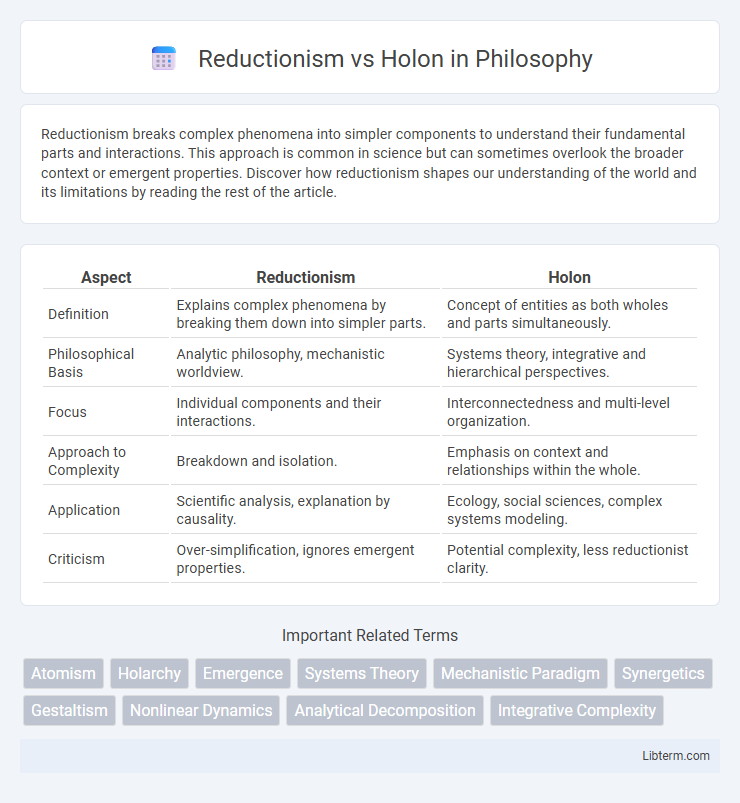Reductionism breaks complex phenomena into simpler components to understand their fundamental parts and interactions. This approach is common in science but can sometimes overlook the broader context or emergent properties. Discover how reductionism shapes our understanding of the world and its limitations by reading the rest of the article.
Table of Comparison
| Aspect | Reductionism | Holon |
|---|---|---|
| Definition | Explains complex phenomena by breaking them down into simpler parts. | Concept of entities as both wholes and parts simultaneously. |
| Philosophical Basis | Analytic philosophy, mechanistic worldview. | Systems theory, integrative and hierarchical perspectives. |
| Focus | Individual components and their interactions. | Interconnectedness and multi-level organization. |
| Approach to Complexity | Breakdown and isolation. | Emphasis on context and relationships within the whole. |
| Application | Scientific analysis, explanation by causality. | Ecology, social sciences, complex systems modeling. |
| Criticism | Over-simplification, ignores emergent properties. | Potential complexity, less reductionist clarity. |
Understanding Reductionism: A Foundational Overview
Reductionism dissects complex systems into simpler components to analyze their properties and interactions, aiming to explain phenomena through fundamental parts such as molecules, cells, or individual agents. This approach underpins scientific methods by isolating variables and establishing causal relationships at micro levels, facilitating predictability and control in disciplines like physics, biology, and cognitive science. Understanding reductionism involves recognizing its limits in capturing emergent properties that arise only within integrated wholes, which holistic or holonic perspectives attempt to address.
The Holon Concept: Defining Wholes and Parts
The Holon concept redefines systems by emphasizing that every entity is simultaneously a whole and a part, challenging traditional reductionism which isolates components from their context. Holons maintain autonomy while integrating into larger wholes, creating dynamic hierarchies that reflect both independence and interdependence. This framework enhances understanding of complex systems in fields like biology, psychology, and organizational theory by bridging micro and macro perspectives.
Philosophical Roots of Reductionism
Reductionism traces its philosophical roots to figures such as Rene Descartes, who emphasized breaking down complex phenomena into simpler parts to understand the whole. This approach assumes that the properties of a system can be fully explained by its constituent elements, aligning with mechanistic and materialist traditions in philosophy. Critics argue that reductionism overlooks emergent properties and relational aspects captured by holistic or holon perspectives, which recognize systems as integrated and interdependent wholes.
Historical Evolution of Holonic Theory
Holonic theory emerged in the 1970s as a response to the limitations of reductionism, emphasizing the simultaneous autonomy and interdependence of system components known as holons. This concept was first introduced by Arthur Koestler, who highlighted how holons function as both wholes and parts within hierarchical structures, facilitating more robust models of complex systems compared to traditional reductionist approaches. Over time, holonic theory has evolved to influence fields such as organizational management, artificial intelligence, and cyber-physical systems, promoting integrated perspectives that balance localization and global system coherence.
Comparing Methodologies: Analysis vs. Synthesis
Reductionism employs analysis by breaking down complex systems into their fundamental parts to understand behavior at the most basic level. In contrast, the Holon approach emphasizes synthesis, integrating parts into coherent wholes that exhibit emergent properties beyond individual components. This comparison reveals reductionism's focus on isolated elements, whereas holons prioritize the interconnectedness and dynamic relationships within systems.
Applications in Science and Systems Thinking
Reductionism, which analyzes complex systems by dissecting them into simpler components, facilitates targeted research in fields like molecular biology and physics by isolating individual variables. Holon theory, emphasizing systems as wholes composed of interdependent parts called holons, enhances understanding in ecology and organizational science by recognizing nested hierarchies and dynamic interactions. Integrating reductionism with holon perspectives advances systems thinking, enabling comprehensive models that address both detailed elements and emergent properties in scientific research and complex system management.
Limitations and Criticisms of Reductionism
Reductionism faces criticism for oversimplifying complex systems by breaking them down into isolated parts, often ignoring the emergent properties and interactions that define the whole. This approach limits understanding in fields like biology, psychology, and ecology, where holistic perspectives reveal relationships that reductionist methods overlook. The Holon concept addresses these limitations by emphasizing systems as integrated wholes composed of interdependent parts, facilitating a more comprehensive analysis of complexity.
Advantages of the Holonic Perspective
The holonic perspective enhances system analysis by acknowledging both the autonomy and interdependence of components, leading to improved adaptability and resilience. It facilitates multi-level problem-solving by integrating individual element functions with overarching system goals, optimizing overall efficiency. This approach supports scalable design in complex systems such as manufacturing, robotics, and organizational management, promoting robustness and flexibility.
Integrating Reductionist and Holonic Approaches
Integrating reductionist and holonic approaches enhances system analysis by combining detailed component-level understanding with holistic perspectives of interconnected wholes. This synergy supports more effective problem-solving in complex systems such as biological networks, artificial intelligence, and organizational management. Employing both methodologies allows for scalable models that reflect both micro-level functionalities and macro-level emergent properties.
Future Directions: Embracing Complexity in Inquiry
Future directions in inquiry emphasize embracing complexity by integrating reductionism with holon theory to better understand systems as interconnected wholes and parts simultaneously. Advancements in multidisciplinary research and computational modeling enable deeper analysis of emergent properties beyond isolated components. This holistic approach promotes innovation in fields such as systems biology, cognitive science, and environmental studies, driving more comprehensive and adaptive solutions.
Reductionism Infographic

 libterm.com
libterm.com